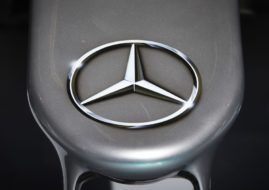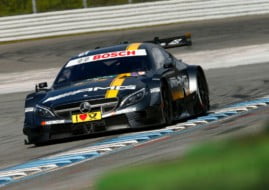Original Mercedes Silver Arrows - Models W25 and W125
The name Silver Arrow (german: Silberpfeil), which commonly describes the Mercedes-Benz racing cars, has been around in the world of motorsports for more than 80 years: from the astonishing racing cars back in the 1930s, to Formula One cars in the 1950s and the modern Formula One cars of the German manufacturer. However, the origins of the name are controversial and there are a few stories about how the Silver Arrows came into being.
Neubauer’s biography reveals the truth
Alfred Neubauer was the racing manager of the Mercedes-Benz Grand Prix team from 1926 to 1955, so the story in his biography, which was published in 1958, could be relevant. The story says that in 1934, they were forced to strip some weight off the Mercedes-Benz W25 before the scrutineering prior to the Eifelrennen at the Nürburgring.
Neubauer and his driver Manfred von Brauchitsch (who also wrote his memoirs) claimed that they had the idea of removing all the white paint from the bodywork. The silver-coloured aluminium-bodied W25 won the race and the nickname Silver Arrow allegedly came into being.

Mercedes’ chiefs and workers around W25 racing car in 1934
Auto Union had also done racing with silver cars
At that time, Auto Union also raced with silver cars, so some sources claim that both Mercedes’ and Auto Union’s cars were called Silver Arrows during the live radio coverage of Avusrennen in 1932. The usage of polished and non-painted aluminium panels was understandable because they were really saving the weight, so the aircraft industry also built planes out of aluminium.
That brings us to the next questions – what kind of cars were the 1930s Silver Arrows and who were the drivers? The first was the Mercedes-Benz W25, designed for the 1934 Grand Prix season as a replacement for the Mercedes-Benz SSK. According to new regulations, the maximum weight was 750 kg. A supercharged straight-8 3.4-liter engine was used, longitudinally mounted in front of the driver. At 350hp, the engine was more powerful than the previous 7-liter engine of the SSK.

Manfred von Brauchitsch scored first victory for W25 at Eifelrennen at Nürburgring
Mercedes W25 took the 1935 European Championship title
The W25 debuted at Avusrennen in May 1934, but mechanical issues forced Mercedes to withdraw. The next race at Nürburgring was successful and Manfred von Brauchitsch won. Later in the season, W25 won three more races (Coppa Acerbo, Spanish Grand Prix and Italian Grand Prix) with Rudolf Caracciola and Luigi Fagioli as drivers.
In 1935, the European Championship was resumed and Caracciola took the title by winning three of five races. Fagioli added three more wins in other GP races. During 1936, the engine capacity was increased to over 4 liters and power output was north of 400hp. In the next development phase, the engine was expanded to 4.7-liters with 490 hp. The bigger engine demanded a lighter chassis, so the W25 was shortened and became the W25K (kurz, short). Caracciola won only two races (Monaco and Tunisia), so Mercedes decided to focus on developing a new car.

Mercedes-Benz W125 was introduced in 1937
Mercedes W125 was a monster with almost 650 hp
Thus in 1937, the Mercedes-Benz W125 was introduced. The 5.6-liter supercharged Straight-8 engine had an output of up to 595hp in race trim. The highest power measured during testing was 646 hp. For 1938, the engine capacity of the supercharged GP cars was limited to 3000cc, so the W125 was used only for one season, but it was a season to remember.
Rudolf Caracciola won the European Championship with three wins in five races, while his teammates were second (Manfred von Brauchitsch), third (Hermann Lang) and fourth (Christian Kautz) in the classification. Karl Ebb, Lang and Caracciola added four more non-championship wins.

Mercedes-Benz W125 Rekord Wagen reached the speed of 432,7 km/h
The cars from 1937 remained the most powerful over the next 30 years
The racing cars of the time were real monsters. Considering that an average saloon car of that time had around 25 horsepower, 600 and more hp in racing cars were considered extremely high, so regulations forced manufacturers to limit engine capacity and reduce their power. Because of that, the cars from 1937 onward remained at the peak of power over the next 30 years, while in Formula One their power was not exceeded until the early 1980s.
The Mercedes-Benz W125 reached race speeds of more than 300 km/h, while W125 Recordwagen (equiped with 725-hp 5.6L V12 engine) broke the world record with speed of 432.7 km/h. The record was set by Rudolf Caracciola in January 1938. The record breaking run was made on the Reichs-Autobahn A5 between Frankfurt and Darmstadt. Unfortunately, Bernd Rosemeyer was killed later the same day while trying to beat that record for Auto Union. The public road speed record still remains unbeaten.
Caracciola’s record, championship victories, brutal force and all the danger that comes with it made Mercedes-Benz W125 one of the most legendary cars in a history of motorsport, although it lived only one season. Because of that car, the name Silver Arrows earned the respect which stands for decades.

Mercedes-Benz W154 was a successor of W125
The World War II stopped the progress of the original Silver Arrows
The next Silver Arrow was W154, designed according to the rules changes for the 1938 Grand Prix season. It used a 3.0L V12 engine, with power output of between 425 and 475 hp. Rudolf Caracciola won the European Championship again. Season 1939 was stopped because of World War II and that was the end of the story of the original Silver Arrows.
The glorious story continued in 1952, when Mercedes re-entered races the first time after the War. The car was the iconic W194 300SL, which scored a 1-2 victory at the 1952 24 Hours of Le Mans and some other famous races (Carrera Panamericana, Eifelrennen…) Racing success was followed by the birth of the legendary 300SL Gullwing road car in 1954.

Mercedes entered Formula One championship with W196R in 1954 (cars number 18, 20 and 22)
W196 was the Silver Arrow of the 1950s
In the same year, Mercedes entered the Formula One championship, which was inaugurated a few years earlier in 1950. The first year of participation was remarkable, as Juan Manuel Fangio won the championship title with the new Silver Arrow – the W196. Fangio started the season with Maserati but after two wins he switched to Mercedes and scored four more victories.
In 1955, Fangio recorded four wins and again took the title, while his new team-mate Stirling Moss won at British Grand Prix. In the 300 SLR (W196) Stirling Moss also scored a historic victory at 1955 Mille Miglia.

Famous Mercedes #722 at the 1955 Mille Miglia
Mercedes’ withdrawal after the 1955 Le Mans disaster
The season of 1955 was disastrous in terms of mortality. During the same year, Alberto Ascari, Mario Alborghetti, Manny Ayulo and Bill Vukovich died in racing accidents, but the worst tragedy of them all happened at the 1955 24 Hours of Le Mans.
Mercedes’ driver Pierre Levegh crashed into spectators and caused the death of more than 80 people. This was the worst racing accident in the history of motorsport and one of the consequences was Mercedes’ withdrawal from racing, which lasted until the team’s revival in 2010.
Video : The sound of Mercedes Benz Silver Arrows – W125, W154, and W165
;






